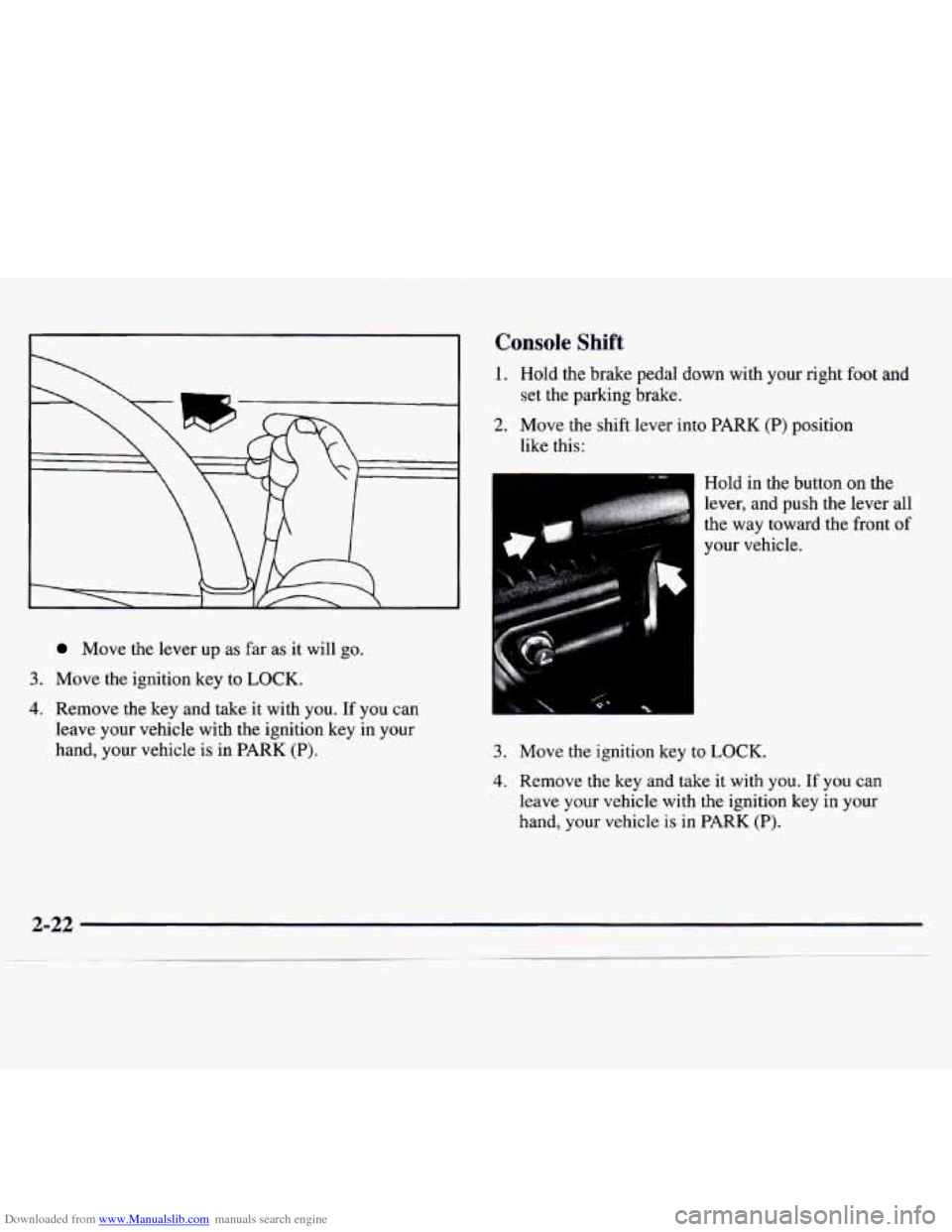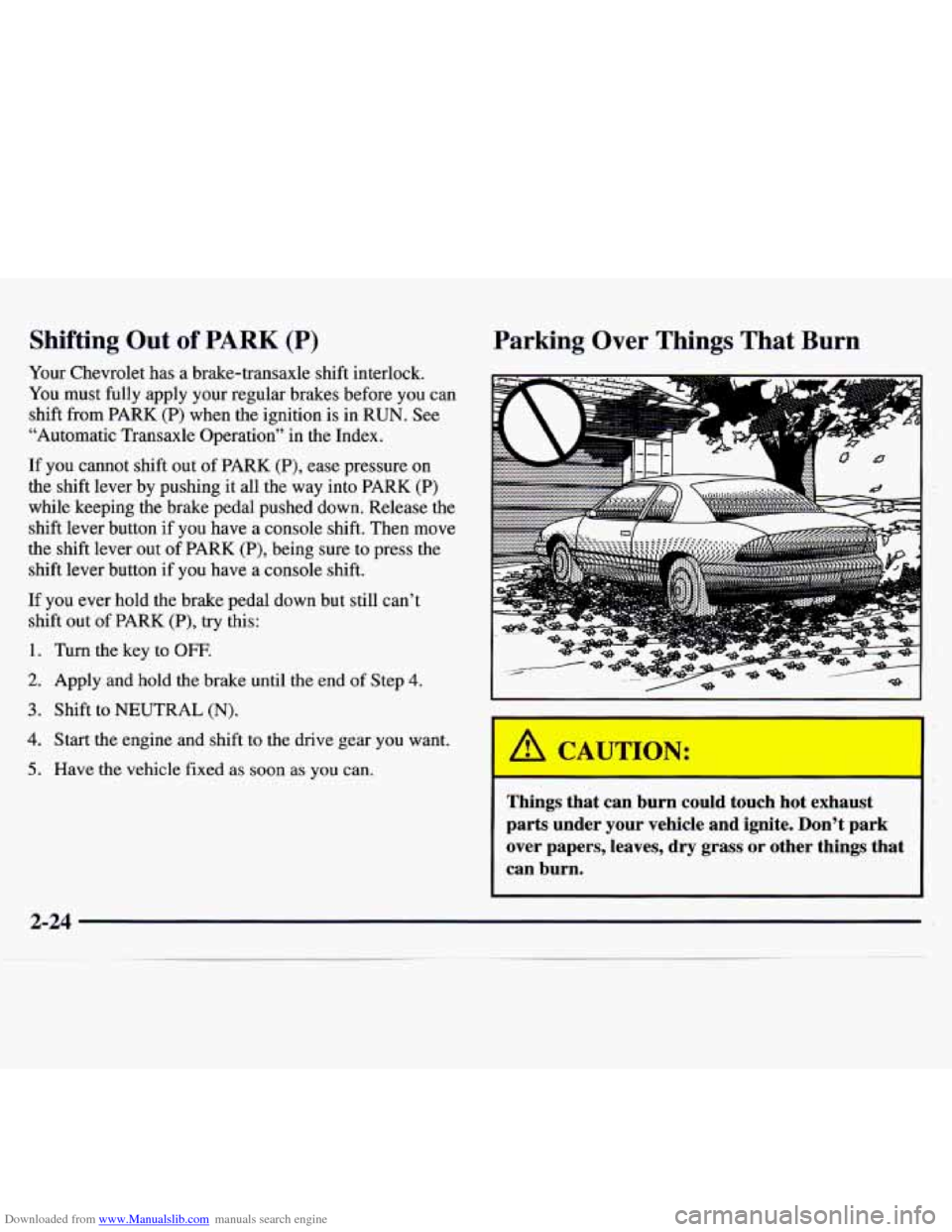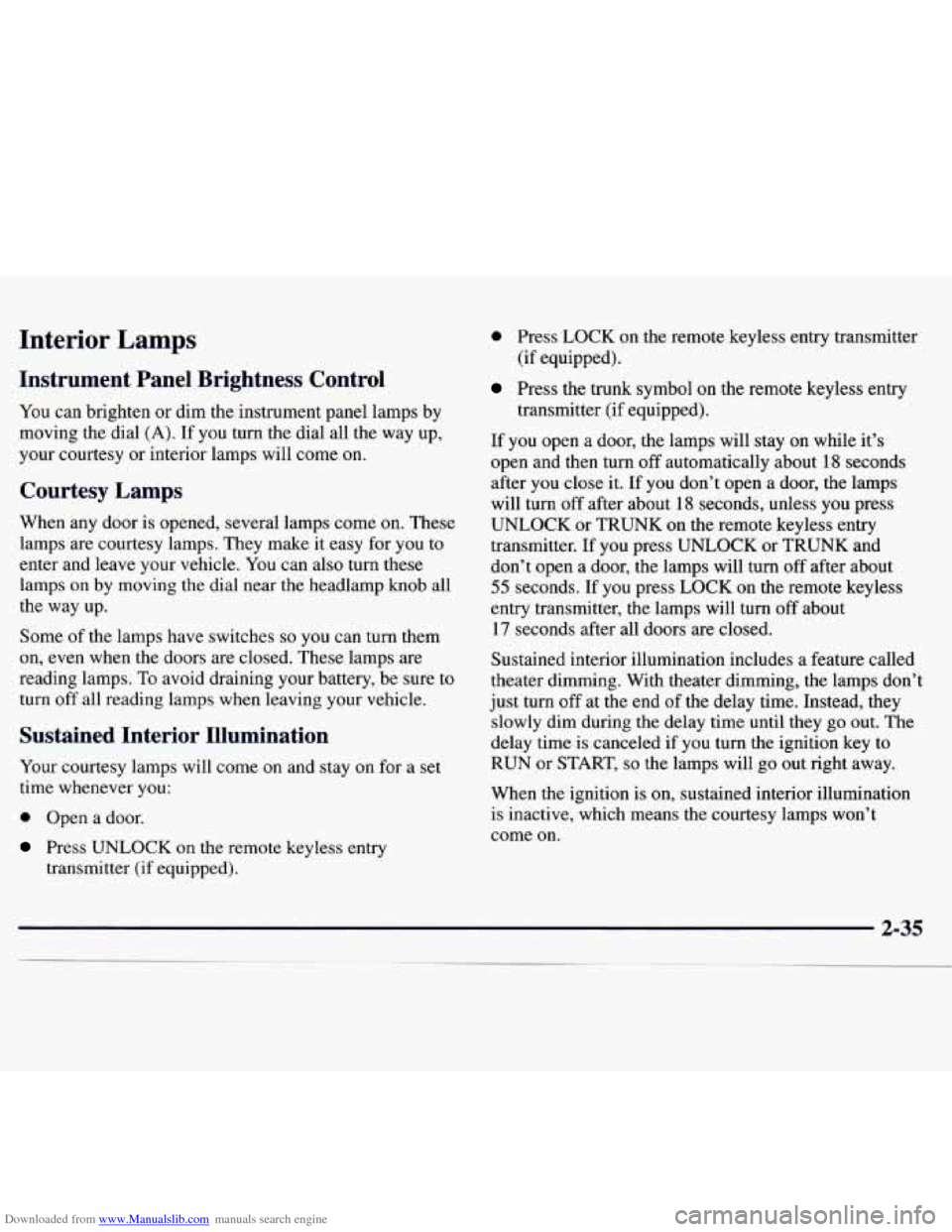1997 CHEVROLET MONTE CARLO key
[x] Cancel search: keyPage 73 of 358

Downloaded from www.Manualslib.com manuals search engine 1. Without pushing the accelerator pedal, turn your
ignition key to
START. When the engine starts, let
go
of the key. The idle speed will go down as your
engine gets warm.
I NOTICE:
Holding your key in START for longer than
15 seconds at a time will cause your battery to be
drained much sooner. And the excessive heat can
damage your starter motor.
2. If your engine won’t start (or starts but then stops), it
could be flooded with too much gasoline. Try
pushing your accelerator pedal all the way to the
floor and holding it there as you hold the key in
START
for up to 15 seconds. This clears the extra
gasoline from the engine.
Your engine is designed to work with the
electronics in your vehicle.
If you add electrical
parts
or accessories, you could change the way
the engine operates. Before adding electrical
equipment, check with your dealer.
If you don’t,
your engine might not perform properly.
If you ever have to have your vehicle towed, see
the part of this manual that tells how
to do it
without damaging your vehicle. See “Towing
Your Vehicle” in the Index.
NOTICE:
2-14
.~ ~
Page 81 of 358

Downloaded from www.Manualslib.com manuals search engine Move the lever up as far as it will go.
3. Move the ignition key to LOCK.
4. Remove the key and take it with you. If you can
leave your vehicle with the ignition key in your
hand, your vehicle is in PARK
(P).
Console Shift
1. Hold the brake pedal down with your right foot and
2. Move the shift lever into PARK (P) position
set
the parking brake.
like this:
Hold in the button on the
lever, and push the lever all
the way toward the front of
your vehicle.
3. Move the ignition key to LOCK.
4. Remove the key and take it with you. If you can
leave your vehicle with the ignition key in your
hand, your vehicle is in
PARK (P).
Page 83 of 358

Downloaded from www.Manualslib.com manuals search engine Shifting Out of PARK (P)
Your Chevrolet has a brake-transaxle shift interlock.
You must fully apply your regular brakes before you can
shift from PARK (P) when the ignition
is in RUN. See
“Automatic Transaxle Operation” in the Index.
If you cannot shift out of PARK (P), ease pressure
on
the shift lever by pushing it all the way into PARK (P)
while keeping the brake pedal pushed down. Release the
shift lever button if you have a console shift. Then move
the shift lever out of PARK
(P), being sure to press the
shift lever button if
you have a console shift.
If you ever hold the brake pedal down but still can’t
shift out
of PARK (P), try this:
1.
2.
3.
4.
5.
Turn the key to OFF.
Apply and hold the brake until the end of Step 4.
Shift to NEUTRAL (N).
Start the engine and shift to the drive gear you want.
Have the vehicle fixed
as soon as you can.
Parking Over Things That Burn
Things that can burn could touch hot exhaust
parts under your vehicle and ignite. Don’t park
over papers, leaves, dry grass
or other things that
can burn.
2-24
Page 94 of 358

Downloaded from www.Manualslib.com manuals search engine Interior Lamps
Instrument Panel Brightness Control
You can brighten or dim the instrument panel lamps by
moving the dial
(A). If you turn the dial all the way up,
your courtesy or interior lamps will come on.
Courtesy Lamps
When any door is opened, several lamps come on. These
lamps are courtesy lamps. They make
it easy for you to
enter and leave your vehicle. You can also turn these
lamps on by moving the dial near the headlamp knob all
the way up.
Some of the lamps have switches
so you can turn them
on, even when the doors are closed. These lamps are
reading lamps.
To avoid draining your battery, be sure to
turn off all reading lamps when leaving your vehicle.
Sustained Interior Illumination
Your courtesy lamps will come on and stay on for a set
time whenever you:
0 Open a door.
0 Press LOCK on the remote keyless entry transmitter
(if equipped).
Press the trunk symbol on the remote keyless entry
transmitter (if equipped).
If you open
a door, the lamps will stay on while it’s
open and then turn
off automatically about 18 seconds
after you close
it. If you don’t open a door, the lamps
will turn off after about
18 seconds, unless you press
UNLOCK or TRUNK on the remote keyless entry
transmitter. If you press UNLOCK or TRUNK and
don’t open a door, the lamps will turn off after about
55 seconds. If you press LOCK on the remote keyless
entry transmitter, the lamps will turn
off about
17 seconds after all doors are closed.
Sustained interior illumination includes a feature called
theater dimming. With theater dimming, the lamps don’t
just turn off
at the end of the delay time. Instead, they
slowly dim during the delay time until they go out. The
delay time is canceled if you turn the ignition key to
RUN or START,
so the lamps will go out right away.
When the ignition is on, sustained interior illumination
is inactive, which means the courtesy lamps won’t
come on.
Press UNLOCK on the remote keyless entry
transmitter (if equipped).
2-35
Page 97 of 358

Downloaded from www.Manualslib.com manuals search engine Storage Compartments
Glove Box
Use the door key to lock and unlock the glove box. To
open, lift the latch.
Storage Armrest
To use the storage area, fold
down the armrest. Press
the
latch on the front edge and
pull up.
To use the
cupholder, flip it forward.
Instrument Panel Cupholder
J
To use this
slide it out
instrument cupholder,
of the
panel.
Door Storage Compartments
Each of the doors has a storage compartment.
Page 107 of 358

Downloaded from www.Manualslib.com manuals search engine Warning Lights, Gages and Indicators
This part describes the warning lights and gages that
may be on your vehicle. The pictures will help you
locate them.
Warning lights and gages can signal that something is
wrong before it becomes serious enough to cause an
expensive repair or replacement. Paying attention to
your warning lights and gages could also save you or
others from injury.
Warning lights come on when there may be or is a
problem with one
of your vehicle’s functions. As you
will see in the details on the next few pages, some
warning lights come on briefly when you start the
engine just to let you know they’re working.
If you are
familiar with this section, you should not be alarmed
when this happens.
Gages can indicate when there may be or is a problem
with one of your vehicle’s functions. Often gages and
warning lights work together to let you know when
there’s a problem with your vehicle. When
one
of the warning lights comes on and stays on
when you are driving, or when one of the gages shows
there may be a problem, check the section that tells you
what to do about it. Please follow this manual’s advice.
Waiting to do repairs can be costly
-- and even
dangerous.
So please get to know your warning lights
and gages. They’re a big help.
Safety Belt Reminder Light
When the key is turned to RUN or START, a chime will
come on for about eight seconds to remind people to
fasten their safety belts, unless the driver’s safety belt is
already buckled.
The safety belt light will
also come on and stay on
until the driver’s belt
is buckled.
Page 108 of 358

Downloaded from www.Manualslib.com manuals search engine Air Bag Readiness Light
There is an air bag readiness light on the instrument
panel, which shows AIR
BAG or the air bag symbol.
The system checks the air bag’s electrical system for
malfunctions. The light tells you
if there is an electrical
problem. The system check includes the air bag sensors,
the air bag modules, the wiring and the crash sensing
and diagnostic module. For more information on the air
~ bag system, see “Air Bag” in the Index.
AIR BAG
This light will come on
when you start your engine,
and it will flash for a few
seconds. Then the light
should go out. This means
the system is ready. The
air bag readiness light should flash for a few
seconds when you turn the ignition key to RUN.
If the
light doesn’t come on then, have it fixed
so it will be
ready to warn you if there is a problem.
Charging System Light
If the air bag readiness light stays on after you start the
engine or comes on when you are driving, your air bag
system may not work properly. Have your vehicle
serviced right away.
VOLTS
The charging system light
will come on briefly when
you turn on the ignition, as
a check to show you it’s
working. Then it should
go out.
If
it stays on, or comes on while you are driving, you
may have a problem with the charging system. It could
indicate that you have a loose drive ‘belt or another
electrical problem. Have it checked right away. Driving
while this light is on could drain your battery.
If you must drive a short distance with the light on, be
certain to turn
off all your accessories, such as the radio
and air conditioner.
2-49
Page 109 of 358

Downloaded from www.Manualslib.com manuals search engine Brake System Warning Light
Your Chevrolet’s hydraulic brake system is divided into
two parts. If
one part isn’t working, the other part can
still work and stop you. For good braking, though, you
need both parts working well.
If the warning light comes on, there could be a brake
problem. Have your brake system inspected right away.
BRAKE
This light should come on
briefly when you turn the
ignition key to
RUN. If
it doesn’t come on then,
have it fixed
so it will be
ready
to warn you if there’s
a problem.
If the light comes on while you are driving, pull off the
road and stop carefully. You may notice that the pedal
is
harder to push. Or, the pedal may go closer to the floor. It may take
longer to stop.
If the light is still on, or if the
anti-lock brake system warning light is flashing, have
the vehicle towed for service. (See “Anti-Lock Brake
System Warning Light” and “Towing Your Vehicle” in
the Index.)
Your brake system may not be working properly
if the brake system warning light is on. Driving
with the brake system warning light on can lead
to an accident. If the light is still on or if the
anti-lock brake system warning light is flashing
after you’ve pulled
off the road and stopped
carefully, have the vehicle towed for service.
When the ignition is on, the brake system warning light
will also come on when you set your parking brake. The
light will stay
on if your parking brake doesn’t release
fully.
If it stays on after your parking brake is fully
released, it means you have a brake problem.